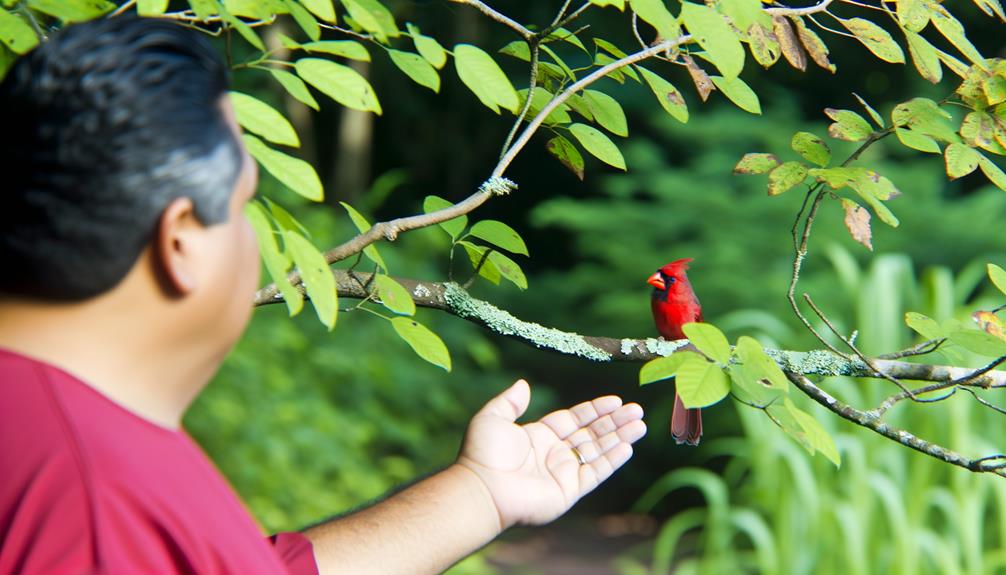Injured Cardinal: Who Do You Call for Essential Help?
If you find an injured cardinal, quick attention is crucial. Start by carefully wrapping the bird in a soft fabric and placing it in a calm, softly lit, well-ventilated container.
Refrain from providing food or water. Get in touch with your nearby wildlife rehabilitator, state wildlife agency, or a veterinarian.
They possess the knowledge and resources necessary for correct care. You can also contact local animal control for help.
Timely, expert intervention greatly enhances the bird's prospects of survival and recovery. Learn more steps to ensure top-notch care for the cardinal and successful rehabilitation.

Key Takeaways
- Contact your State Wildlife Agency for guidance and assistance with injured wild birds.
- Reach out to local veterinary clinics, as they may provide immediate care or referrals.
- Use online directories to find licensed wildlife rehabilitators in your area.
- Community organizations dedicated to wildlife can offer support and resources.
- Animal control services can assess the situation and handle the bird properly.
Identifying an Injured Cardinal
How can you recognize the signs of an injured cardinal?
Identifying an injured cardinal requires careful observation. Look for physical indicators such as fluffed feathers, visible wounds, or an inability to fly. Behavioral signs include lethargy, unusual quietness, or a lack of response to nearby threats. Cardinals may also exhibit difficulty in perching or balancing, and could show signs of distress through erratic movements.
Observing these symptoms can help determine if the bird is in immediate need of assistance. Additionally, a cardinal that remains grounded or displays abnormal posture is likely injured. Recognizing these signs is essential, as timely intervention can greatly improve the bird's chances of recovery and survival.
Assessing the Severity
When evaluating the seriousness of a cardinal's injury, it is important to systematically evaluate both physical and behavioral symptoms to determine the appropriate course of action. Physical symptoms may reveal the nature and extent of the injury, while behavioral changes can indicate distress or underlying issues.
Key indicators to assess include:
- Visible wounds such as cuts, abrasions, or broken bones.
- Feather condition: missing or ruffled feathers can suggest trauma.
- Mobility difficulties: trouble flying or walking indicates potential skeletal or muscular damage.
- Behavioral anomalies: lethargy, unresponsiveness, or unusual aggression can signal severe stress or internal injuries.
A thorough evaluation of these symptoms will guide you in determining the cardinal's condition and the urgency of seeking professional care.
Immediate Actions to Take
Upon identifying an injured cardinal, promptly and gently secure the bird to prevent further harm and minimize stress. Use a soft cloth or towel to carefully wrap the cardinal, ensuring its wings are held close to its body. This action not only immobilizes the bird to prevent flapping and potential injuries but also provides a sense of security.
Place the bird in a ventilated, enclosed container such as a cardboard box with air holes. Keep the environment quiet and dimly lit to reduce stress. Avoid offering food or water, as improper feeding can exacerbate injuries.
Maintain a calm demeanor to soothe the bird while you proceed to the next steps in seeking professional assistance for its care.
Finding Local Wildlife Rehabilitators
Locating a qualified wildlife rehabilitator is essential for ensuring that the injured cardinal receives the specialized care it needs to recover. Wildlife rehabilitators possess the necessary expertise to handle and treat wild birds properly. To find a local rehabilitator, consider the following resources:
- State Wildlife Agencies: Often provide lists of licensed rehabilitators.
- Local Veterinary Clinics: May know nearby wildlife rehabilitation centers.
- Online Directories: Websites like Wildlife Rehabilitation Information Directory can be valuable.
- Community Organizations: Local Audubon Society chapters or animal welfare groups often have contacts.
These resources can guide you to professionals equipped to offer the appropriate care and increase the chances of a successful recovery for the injured cardinal. Prioritize swift action to enhance the bird's survival prospects.
Contacting Animal Control
When encountering an injured cardinal, contacting your local animal control services can provide immediate and specialized assistance. These professionals are equipped to handle emergency wildlife situations and can guarantee the bird receives the necessary care.
Reporting injured animals promptly can make a significant difference in their recovery and well-being.
Local Animal Control Services
Frequently, the most effective step in assisting an injured cardinal is to contact local animal control services for professional intervention. These experts are equipped to handle wildlife emergencies and provide the necessary care. Engaging animal control helps guarantee the bird's safety and increases its chances of recovery.
Here are some key points to bear in mind:
- Assessment: Trained personnel can accurately assess the cardinal's condition.
- Specialized Equipment: They have the tools needed to safely capture and transport the bird.
- Experience: Their expertise in handling wildlife ensures minimal stress for the injured animal.
- Legal Compliance: They operate within legal guidelines, ensuring ethical treatment and adherence to wildlife protection laws.
Emergency Wildlife Assistance
In emergencies involving injured wildlife, contacting animal control is a vital step to make certain that the animal receives prompt and appropriate care. Animal control professionals are trained to handle wildlife emergencies and can provide necessary medical attention or transport the animal to a specialized facility.
Immediate intervention is essential to prevent further harm and guarantee the best possible outcome for the injured creature. These experts also have the knowledge to assess the situation and determine the most humane course of action.
Reporting Injured Animals
Contacting animal control promptly is crucial when reporting an injured animal to make certain it receives the necessary care and intervention. Acting swiftly can greatly impact the animal's chance of recovery and welfare.
When you encounter an injured cardinal or any wildlife, follow these steps:
- Assess the situation: Ensure your own safety and determine the severity of the animal's injury.
- Document details: Note the animal's location, condition, and any observable injuries.
- Contact local animal control: Provide them with all pertinent information for an efficient response.
- Follow instructions: Animal control may give specific guidance to ensure both your safety and that of the injured animal.
Understanding these steps can facilitate timely and effective assistance for injured wildlife, reflecting a compassionate and responsible approach.
Communicating With Bird Experts
Reaching out to bird experts is an important step in ensuring that an injured cardinal receives the appropriate care and attention. Bird experts, such as ornithologists and wildlife rehabilitators, possess specialized knowledge that is vital for evaluating the bird's condition and recommending the best course of action. To contact these professionals, utilize resources like local wildlife rehabilitation centers, bird rescue organizations, and veterinary clinics that specialize in avian care.
Provide as much information as possible, including the bird's symptoms, behavior, and the exact location where it was found. Precise, detailed communication enables experts to offer tailored advice and increases the likelihood of a successful recovery for the cardinal.
Ensuring prompt expert consultation demonstrates a commitment to responsible and compassionate wildlife care.
Transporting the Injured Bird
Transporting an injured cardinal requires careful attention to several key factors to guarantee its safety and well-being.
First, select a proper container that is secure and well-ventilated.
Additionally, handle the bird gently and maintain a calm environment throughout the transport to minimize stress and further injury.
Select Proper Container
When preparing to transport an injured cardinal, it is important to select a container that guarantees the bird's safety and minimizes stress. The ideal container should be sturdy, well-ventilated, and dimly lit to reduce the bird's anxiety.
Consider the following options:
- Shoe boxes: Line with soft cloth and poke small air holes.
- Pet carriers: Assure they have a secure, quiet environment.
- Cardboard boxes: Provide ample space and ventilation.
- Plastic storage bins: Use with a well-perforated lid.
Each of these containers offers specific benefits tailored to the cardinal's needs. Remember, the goal is to create a calm and secure environment to facilitate a smooth and gentle transport to a rehabilitation facility or veterinarian.
Ensure Safe Handling
Properly securing the injured cardinal during transport is crucial to prevent further harm and reduce stress. Utilize a small, well-ventilated container lined with a soft cloth to cushion the bird.
Gently place the cardinal inside, guaranteeing minimal movement. Avoid excessive handling; instead, use a light covering to shield the bird from stress-inducing stimuli.
Secure the container in a stable position within your vehicle to prevent jarring movements. Maintain a moderate temperature inside the transport environment to avoid thermal shock.
While driving, keep noise levels low and avoid abrupt stops. These measures will ensure the cardinal remains as comfortable and safe as possible en route to a wildlife rehabilitator or veterinarian.
Maintain Calm Environment
To ensure the injured cardinal remains as calm as possible during transport, it is important to minimize environmental stressors. Creating a peaceful and controlled atmosphere can greatly improve the bird's chances of recovery.
Here are several steps to guarantee a tranquil environment:
- Soft Lighting: Reduce exposure to harsh lights which can cause distress.
- Calm Surroundings: Keep noise levels low to avoid startling the bird.
- Secure Container: Use a ventilated, dim container to limit movement and prevent further injury.
- Gentle Transport: Move the cardinal smoothly and slowly to maintain a stable environment.
These measures, when implemented thoughtfully, help in reducing anxiety and promoting a safer journey for the injured cardinal to a rehabilitation facility.
What to Avoid
While caring for an injured cardinal, it is crucial to avoid handling the bird excessively, as this can cause additional stress and worsen its condition.
Refrain from administering food or water directly, as improper feeding can lead to aspiration or further injury.
Avoid using household remedies or medications not prescribed by a wildlife rehabilitator, as these can be harmful.
Do not attempt to treat fractures or wounds yourself; improper care can lead to infection or permanent damage.
Ensure the bird is kept in a quiet, dark environment, free from disturbances such as loud noises and pets.
Aftercare and Follow-Up
Guaranteeing the injured cardinal receives appropriate aftercare and follow-up is crucial to its full recovery and eventual release back into the wild. Proper aftercare involves several key steps to guarantee the bird's health and readiness for reintroduction:
- Medication Administration: Strict adherence to prescribed medications to combat infections or aid in healing.
- Dietary Management: Providing a balanced diet rich in nutrients to restore strength and essentiality.
- Physical Rehabilitation: Gentle exercises and flight practice to rebuild muscle tone and coordination.
- Regular Health Check-ups: Scheduled visits to a wildlife rehabilitator to monitor progress and make necessary adjustments.
Each of these steps plays a critical role in ensuring the cardinal not only survives but thrives once it returns to its natural habitat.
Conclusion
Helping an injured cardinal requires immediate and informed action. According to the National Audubon Society, approximately 72% of injured birds that receive timely help have a chance of recovery and successful release back into the wild.
Identifying the injury, evaluating severity, contacting local wildlife rehabilitators, and following proper transport protocols are vital steps. Avoiding common mistakes and ensuring aftercare can greatly improve the bird's chances of survival and well-being.




